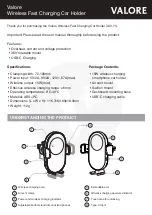
Web
:
http://www.fulibattery.net
Page
3 of 7
Figure 4
Two stage of constant voltage charging is a recommended method for charging valve regulated lead acid battery in a short period of time and then maintain them in a fully charged float or
standby condition. Figure 3 illustrates the characteristics of a two stages constant voltage charging.
Taper Current Charging
This method is not recommended for VRLA batteries for it has somewhat harsh on battery
performance. However, because of the simplicity of the charger circuit and its low cost, taper
current charging is often used to charge a number of series connected batteries that are
subject to cyclic use. If this method is to be used, it is suggested that the
FULI
technical
department should be contacted.
Effect of Temperature on Charging Voltage
As temperature rises, electrochemical activity in a battery increases. Similarly, as
temperature falls, electrochemical activity decreases. Therefore, conversely, as temperature
rises, charging voltage should be reduced to prevent overcharge and increased as
temperature falls to avoid undercharge. In general, to assure optimum service life, use of a temperature compensated charger is recommended. The recommended compensation factor for
DC
batteries
is -3mV/
℃
/Cell (standby use) and-5mV/
℃
/Cell (cyclic use). The standard center point for temperature compensation is 20
℃
. Figure 4 shows the relationship
between
temperatures and charging voltages in both cyclic and standby applications.
Effect of Voltage on Battery Gassing
Although the batteries are of the recombination type and the amount of gassing at normal operating voltages and temperature are
negligible, if the charging voltage is increased, gassing will occur despite the recombination design of the product. Gassing does
not normally occur while the battery is operating under float conditions and normal constant voltage recharge of 2.27-2.30 Vpc at
20
℃
. Very little gassing occurs when the battery is recharged under normal cycling recharge procedures. However, it can be seen
on the accompanying graph the higher voltages that this especially under conditions of constant current charging will substantially
increase the volume of gas.
D
D
I
I
S
S
C
C
H
H
A
A
R
R
G
G
E
E
C
C
H
H
A
A
R
R
A
A
C
C
T
T
E
E
R
R
I
I
S
S
T
T
I
I
C
C
The discharge capacity of a lead acid battery varies and is dependant on the discharge current.
FULI
VRLA battery capacity is
measured at the 20-hour rate.
The standard industry practice to determine the nominal capacity of a valve regulated lead acid
battery is to discharge the battery under test at its 20-Hour rate to a final voltage of 1.75 volts per cell. The curves in Figure 5 show
the different currents that can be drawn at various discharge capacity rates at an ambient temperature of 20
℃
.The rated nominal
capacity of a battery is reduced when it is discharged at a value of current that exceeds its 20-Hour discharge rate. This should be taken into consideration when a battery is being selected
Figure 3

























